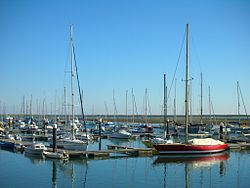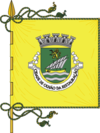Olhão Municipality
| Olhão | |||
|---|---|---|---|
| Municipality | |||

The marina of Olhão, where pleasure boats mix with commercial fishing craft
|
|||
|
|||
 |
|||
| Coordinates: 37°1′30″N 7°50′30″W / 37.02500°N 7.84167°WCoordinates: 37°1′30″N 7°50′30″W / 37.02500°N 7.84167°W | |||
| Country |
|
||
| Region | Algarve | ||
| Subregion | Algarve | ||
| Intermunic. comm. | Algarve | ||
| District | Faro | ||
| Parishes | 4 | ||
| Government | |||
| • President | António Pina (PS) | ||
| Area | |||
| • Total | 130.86 km2 (50.53 sq mi) | ||
| Highest elevation | 403 m (1,322 ft) | ||
| Lowest elevation | 0 m (0 ft) | ||
| Population (2011) | |||
| • Total | 45,396 | ||
| • Density | 350/km2 (900/sq mi) | ||
| Time zone | WET/WEST (UTC+0/+1) | ||
| Postal code | 8700 | ||
| Area code | 289 | ||
| Website | http://www.cm-olhao.pt | ||
Olhão (Portuguese pronunciation: [oˈʎɐ̃w]), or Olhão da Restauração, is a municipality and urban community in the Algarve region of southern Portugal. The population in 2011 was 45,396, in an area of 130.86 km². Located near the regional capital Faro, it is a fishing port, home of the Bela brand sardines and Conserveira do Sul's Manná range of processed fish products. Along with Faro, Loulé, and Tavira, Olhão forms a conurbation with the city of Faro, from the eastern and central Algarve.
Since pre-history, Olhão has had vestiges of human occupation, although the oldest written record dates only from 1378, referring to a place called Olham. The estuary and abundance of water were decisive factors that influenced fishermen, at the beginning of the 17th century, to congregate along the beach of Olhão. The settlement developed even as officials in Faro discouraged concentration along this coast. Yet, the growth of activity here was impulsed by the protection, after the middle of the 17th century, offered by the Fortress of São Lourenço, which guarded the coast and entrance to the estuary, discouraging attacks from corsairs.
The incremental growth of the fishery along the coast and sea, and commercial enterprises associated their growth, provoked a leap in population. As a result, in 1695, the residents requested from the Bishop of Faro, that Olhão should be deannexed from the parish of Quelfes: resulting in the formation of the parish of Nossa Senhora do Rosário de Olhão.
During the French occupation of the Algarve, during the Peninsular Wars, Olhão was notable for one of the few public uprisings against the occupiers, occurring on 16 June 1808. This revolt culimnated in the expulsion of the French from Olhão and, as a result, from the rest of the Algarve. It was during this period, that a month later, a small group of 17 men embarked to Brazil on a caique (a small sailing vessel) named Bom Sucesso, in the hope of promoting the Algarvean success to the Portuguese Court. The crew brought an ex-official statement describing the audacious attitude of the Olhanese revolt. A replica of the boat is moored at Olhão's waterfront.
...
Wikipedia


